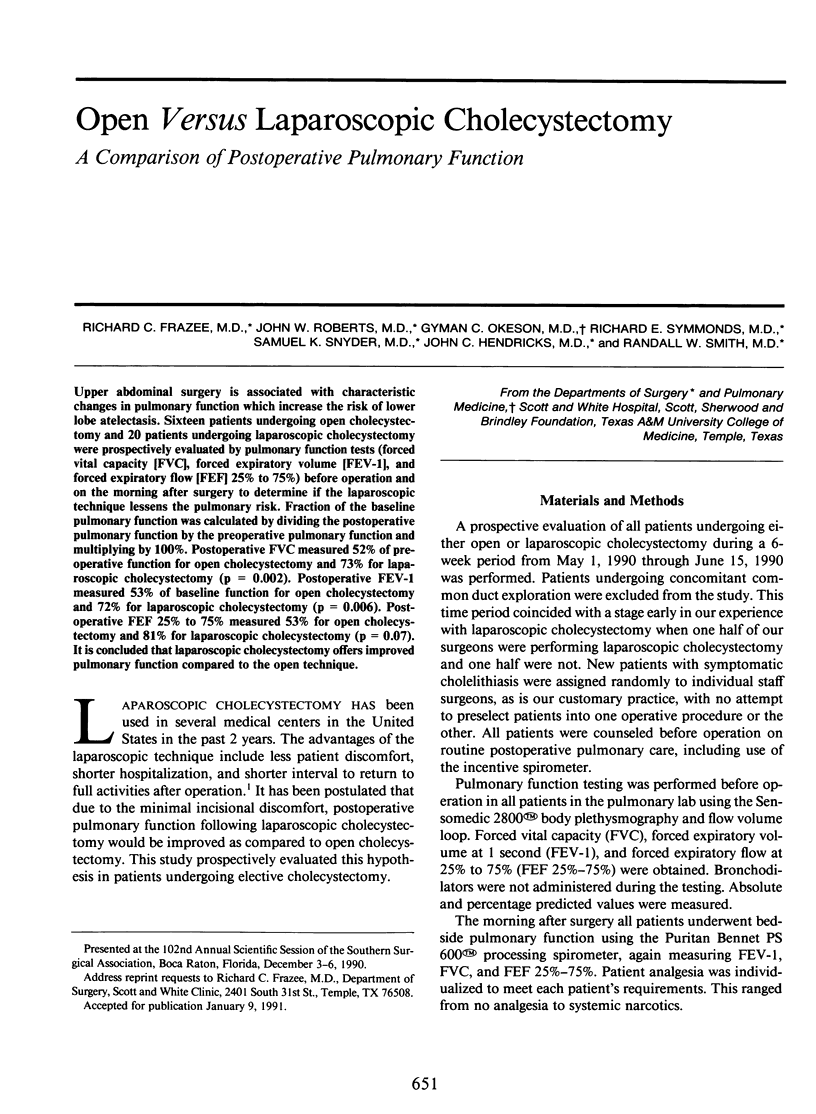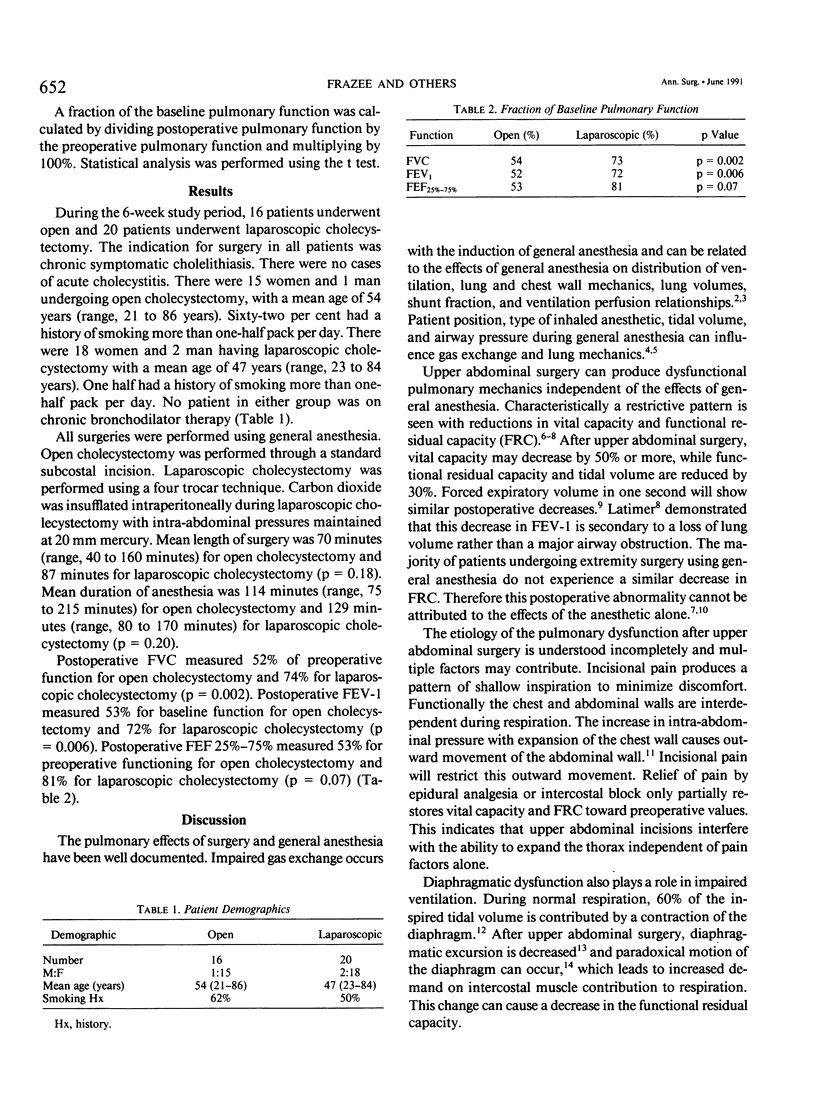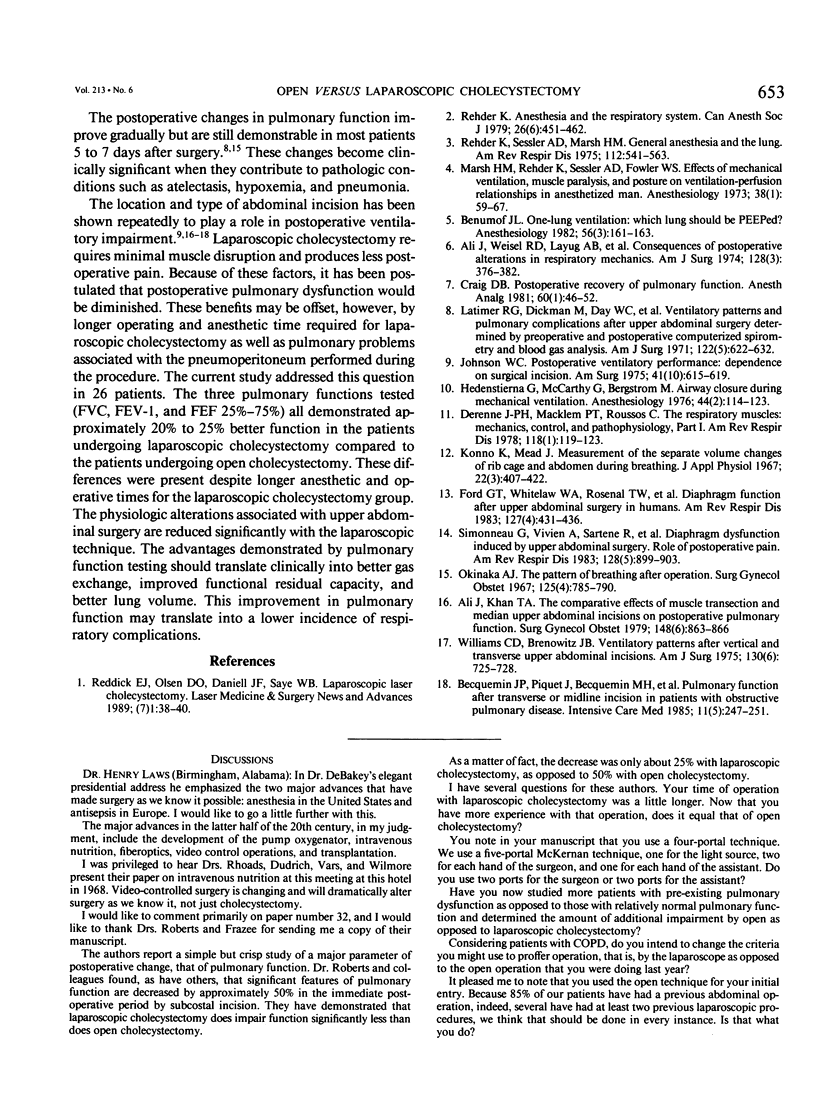Abstract
Upper abdominal surgery is associated with characteristic changes in pulmonary function which increase the risk of lower lobe atelectasis. Sixteen patients undergoing open cholecystectomy and 20 patients undergoing laparoscopic cholecystectomy were prospectively evaluated by pulmonary function tests (forced vital capacity [FVC], forced expiratory volume [FEV-1], and forced expiratory flow [FEF] 25% to 75%) before operation and on the morning after surgery to determine if the laparoscopic technique lessens the pulmonary risk. Fraction of the baseline pulmonary function was calculated by dividing the postoperative pulmonary function by the preoperative pulmonary function and multiplying by 100%. Postoperative FVC measured 52% of preoperative function for open cholecystectomy and 73% for laparoscopic cholecystectomy (p = 0.002). Postoperative FEV-1 measured 53% of baseline function for open cholecystectomy and 72% for laparoscopic cholecystectomy (p = 0.006). Postoperative FEF 25% to 75% measured 53% for open cholecystectomy and 81% for laparoscopic cholecystectomy (p = 0.07). It is concluded that laparoscopic cholecystectomy offers improved pulmonary function compared to the open technique.
Full text
PDF


Selected References
These references are in PubMed. This may not be the complete list of references from this article.
- Ali J., Khan T. A. The comparative effects of muscle transection and median upper abdominal incisions on postoperative pulmonary function. Surg Gynecol Obstet. 1979 Jun;148(6):863–866. [PubMed] [Google Scholar]
- Ali J., Weisel R. D., Layug A. B., Kripke B. J., Hechtman H. B. Consequences of postoperative alterations in respiratory mechanics. Am J Surg. 1974 Sep;128(3):376–382. doi: 10.1016/0002-9610(74)90176-7. [DOI] [PubMed] [Google Scholar]
- Becquemin J. P., Piquet J., Becquemin M. H., Melliere D., Harf A. Pulmonary function after transverse or midline incision in patients with obstructive pulmonary disease. Intensive Care Med. 1985;11(5):247–251. doi: 10.1007/BF00260354. [DOI] [PubMed] [Google Scholar]
- Benumof J. L. One-lung ventilation: which lung should be PEEPed? Anesthesiology. 1982 Mar;56(3):161–163. doi: 10.1097/00000542-198203000-00001. [DOI] [PubMed] [Google Scholar]
- Craig D. B. Postoperative recovery of pulmonary function. Anesth Analg. 1981 Jan;60(1):46–52. [PubMed] [Google Scholar]
- Derenne J. P., Macklem P. T., Roussos C. The respiratory muscles: mechanics, control, and pathophysiology. Am Rev Respir Dis. 1978 Jul;118(1):119–133. doi: 10.1164/arrd.1978.118.1.119. [DOI] [PubMed] [Google Scholar]
- Ford G. T., Whitelaw W. A., Rosenal T. W., Cruse P. J., Guenter C. A. Diaphragm function after upper abdominal surgery in humans. Am Rev Respir Dis. 1983 Apr;127(4):431–436. doi: 10.1164/arrd.1983.127.4.431. [DOI] [PubMed] [Google Scholar]
- Hedenstierna G., McCarthy G., Bergström M. Airway closure during mechanical ventilation. Anesthesiology. 1976 Feb;44(2):114–123. doi: 10.1097/00000542-197602000-00003. [DOI] [PubMed] [Google Scholar]
- Johnson W. C. Postoperative ventilatory performance: dependence upon surgical incision. Am Surg. 1975 Oct;41(10):615–619. [PubMed] [Google Scholar]
- Konno K., Mead J. Measurement of the separate volume changes of rib cage and abdomen during breathing. J Appl Physiol. 1967 Mar;22(3):407–422. doi: 10.1152/jappl.1967.22.3.407. [DOI] [PubMed] [Google Scholar]
- Latimer R. G., Dickman M., Day W. C., Gunn M. L., Schmidt C. D. Ventilatory patterns and pulmonary complications after upper abdominal surgery determined by preoperative and postoperative computerized spirometry and blood gas analysis. Am J Surg. 1971 Nov;122(5):622–632. doi: 10.1016/0002-9610(71)90290-x. [DOI] [PubMed] [Google Scholar]
- Marsh H. M., Rehder K., Sessler A. D., Fowler W. S. Effects of mechanical ventilation, muscle paralysis, and posture on ventilation-perfusion relationships in anesthetized man. Anesthesiology. 1973 Jan;38(1):59–67. doi: 10.1097/00000542-197301000-00016. [DOI] [PubMed] [Google Scholar]
- Okinaka A. J. The pattern of breathing after operation. Surg Gynecol Obstet. 1967 Oct;125(4):785–790. [PubMed] [Google Scholar]
- Rehder K. Anaesthesia and the respiratory system. Can Anaesth Soc J. 1979 Nov;26(6):451–462. doi: 10.1007/BF03006156. [DOI] [PubMed] [Google Scholar]
- Rehder K., Sessler A. D., Marsh H. M. General anesthesia and the lung. Am Rev Respir Dis. 1975 Oct;112(4):541–563. doi: 10.1164/arrd.1975.112.4.541. [DOI] [PubMed] [Google Scholar]
- Simonneau G., Vivien A., Sartene R., Kunstlinger F., Samii K., Noviant Y., Duroux P. Diaphragm dysfunction induced by upper abdominal surgery. Role of postoperative pain. Am Rev Respir Dis. 1983 Nov;128(5):899–903. doi: 10.1164/arrd.1983.128.5.899. [DOI] [PubMed] [Google Scholar]
- Williams C. D., Brenowitz J. B. Ventilatory patterns after vertical and transverse upper abdominal incisions. Am J Surg. 1975 Dec;130(6):725–728. doi: 10.1016/0002-9610(75)90429-8. [DOI] [PubMed] [Google Scholar]


